An Improved High-Pressure Roll Crusher Model for Tungsten and Tantalum Ores
Abstract
1. Introduction
2. Methodology
2.1. Lab-Scale High-Pressure Roll Crusher Test
2.2. Mathematical Approach
- The breakage distribution function parameters should have different values when running under single particle compression compared to running under bed compression. A previous work investigating these materials [24] showed clear differences when the particles were under single particle compression or when they were under the bed compression condition.
- The improved approach should have a selection function that is able to discriminate particles that are large enough to be nipped under the rolls from the remaining particles, which can be subjected to the bed compression effect. Thus, the selection function should be based on the particle size distribution of the feed, the internal products of the model, the geometric dimensions of the device and other characteristics, such as the material density and operational gap.
3. Results and Discussion
3.1. Experimental Results
3.2. Model Capability
4. Conclusions
Author Contributions
Funding
Acknowledgments
Conflicts of Interest
References
- Abouzeid, A.Z.M.; Fuerstenau, D.W. Grinding of mineral mixtures in high-pressure grinding rolls. Int. J. Miner. Process. 2009, 93, 59–65. [Google Scholar] [CrossRef]
- Kellerwessel, H. High pressure material bed comminution in practice. Zement-Kalk-Gips 1990, 2, 57–64. [Google Scholar]
- Hasanzadeh, V.; Farzanegan, A. Robust HPGR model calibration using genetic algorithms. Miner. Eng. 2011, 24, 424–432. [Google Scholar] [CrossRef]
- Genç, Ö.; Benzer, A.H. Effect of High Pressure Grinding Rolls (HPGR) pre-grinding and ball mill intermediate diaphragm grate design on grinding capacity of an industrial scale two-compartment cement ball mill classification circuit. Miner. Eng. 2016, 92, 47–56. [Google Scholar] [CrossRef]
- Aydogan, N.; Ergun, L.; Benzer, H. High pressure grinding rolls (HPGR) applications in the cement industry. Miner. Eng. 2006, 19, 130–139. [Google Scholar] [CrossRef]
- Austin, L.G.; Weller, K.R.; Lim, I.L. Phenomenological Modelling of the High Pressure Grinding Rolls. In Proceedings of the XVIII International Mineral Processing Congress, Sydney, Australia, 23–28 May 1993; pp. 87–95. [Google Scholar]
- Kodali, P.; Dhawan, N.; Depci, T.; Lin, C.; Miller, J. Particle damage and exposure analysis in HPGR crushing of selected copper ores for column leaching. Miner. Eng. 2011, 24, 1478–1487. [Google Scholar] [CrossRef]
- Torres, M.; Casali, A. A novel approach for the modelling of high-pressure grinding rolls. Miner. Eng. 2009, 22, 1137–1146. [Google Scholar] [CrossRef]
- Saramak, D. Technological issues of high-pressure grinding rolls operation in ore comminution processes. Arch. Min. Sci. 2011, 56, 517–526. [Google Scholar]
- Numbi, B.P.; Xia, X. Systems optimization model for energy management of a parallel HPGR crushing process. Appl. Energy 2015, 149, 133–147. [Google Scholar] [CrossRef]
- Barrios, G.; Tavares, L.M. A preliminary model of high pressure rolls grinding using the discrete element method and multi-body dynamics coupling. Miner. Eng. 2016, 156, 32–42. [Google Scholar] [CrossRef]
- Morrel, S.; Lim, W.; Tondo, L. Modelling and scale up of the high pressure grinding rolls. In Proceedings of the XX International Mineral Congress, Aachen, Germany, 21–26 September 1997; pp. 117–126. [Google Scholar]
- Ghorbani, Y.; Mainza, A.N.; Petersen, J.; Becker, M.; Franzidis, J.P.; Kalala, J.T. Investigation of particles with high crack density produced by HPGR and its effect on the redistribution of the particle size fraction in heaps. Miner. Eng. 2013, 43–44, 44–51. [Google Scholar] [CrossRef]
- Fernandez, M.G.; Brochot, S. HPGR modelling with mineral liberation for plant optimization. In Proceedings of the XXVII International Mineral Processing Congress, Santiago, Chile, 20–24 October 2014; pp. 21–31. [Google Scholar]
- Yin, W.; Tang, Y.; Ma, Y.; Zuo, W.; Yao, J. Comparison of sample properties and leaching characteristics of gold ore from jaw crusher and HPGR. Miner. Eng. 2017, 111, 140–147. [Google Scholar] [CrossRef]
- Hamid, S.; Alfonso, P.; Anticoi, H.; Guasch, E.; Oliva, J.; Dosbaba, M.; Garcia-Valles, M.; Chugunova, M. Quantitative mineralogical comparison between HPGR and ball mill products of a Sn-Ta ore. Minerals 2018, 8, 151. [Google Scholar] [CrossRef]
- Saramak, D.; Mlynarczykowska, A.; Krawczykowska, A. Influence of a high pressure comminution technology on concentrate yields in copper ore flotation process. Arch. Metall. Mater. 2014, 59, 951–955. [Google Scholar] [CrossRef]
- Saramak, D.; Wasilewski, S.; Saramak, A. Influence of copper ore comminution in HPGR on downstream minerallurgical process. Arch. Metall. Mater. 2017, 62, 1689–1694. [Google Scholar] [CrossRef]
- Austin, L.G.; Van Orden, D.R.; Pérez, J.W. A preliminary analysis of smooth roll crushers. Int. J. Miner. Process. 1980, 6, 321–336. [Google Scholar] [CrossRef]
- Austin, L.G.; Trubelja, P.M. The capacity and product size distribution of high pressure grinding rolls. In Proceedings of the IV Meeting of the Southern Hemisphere of Mineral Technology, Concepción, Chile, 20–23 November 1994; pp. 49–67. [Google Scholar]
- Schneider, C.; Alves, V.; Austin, L. Modelling the contribution of specific grinding pressure for the calculation of HPGR product size distribution. Miner. Eng. 2009, 22, 642–649. [Google Scholar] [CrossRef]
- Kronemberger, V. Metodologia para Simulação e Escalonamento de Prensas de Rolos. Ph.D. Thesis, Universida de Federal de Minas Gerais, Belo Horizonte, Brazil, 2012. (In Portuguese). [Google Scholar]
- Dundar, H.; Benzer, H.; Aydogan, N. Application of population balance model to HPGR crushing. Miner. Eng. 2013, 50–51, 114–120. [Google Scholar] [CrossRef]
- Anticoi, H.; Guasch, E.; Hamid, S.A.; Alfonso, P.; Oliva, J.; Bascompta, M.; Sanmiquel, L.; Escobet, A.; Argelaguet, R.; Escobet, T.; et al. Mineral and mechanical characterization of tantalum and tungsten ores. Minerals 2018, 8, 170. [Google Scholar] [CrossRef]
- Alfonso, P.; Hamid, S.; Garcia-Valles, M.; Llorens, T.; López Moro, J.; Tomasa, O.; Calvo, D.; Guasch, E.; Anticoi, H.; Oliva, J. Textural and mineral-chemistry constraints on columbite-group minerals in the Penouta deposit: Evidence from magmatic and fluid-related processes. Mineral. Mag. 2018. [Google Scholar] [CrossRef]
- Evertsson, C.M.; Bearman, R.A. Investigation of inter-particle breakage as applied to cone crushing. Miner. Eng. 1997, 10, 199–214. [Google Scholar] [CrossRef]
- Whiten, W.J.; Walter, G.W.; White, M.E. A breakage function suitable for crusher models. In Proceedings of the IV Tewkesbury Symposium, Melbourne, Australia, 12–14 February 1979; pp. 19.1–19.3. [Google Scholar]
- Nikolov, S. Modelling and simulation of particle breakage in impact crushers. Int. J. Miner. Process. 2004, 74S, S219–S225. [Google Scholar] [CrossRef]
- Willmott, C.; Matsuura, K. Advantages of the mean absolute error (MAE) over the root mean square error (RMSE) in assessing average model performance. Clim. Res. 2005, 30, 79–82. [Google Scholar] [CrossRef]
- Roy, K.; Das, R.N.; Ambure, P.; Aher, R. Be aware of error measures. Further studies on validation of predictive QSAR models. Chem. Intell. Lab. Syst. 2016, 152, 18–33. [Google Scholar] [CrossRef]
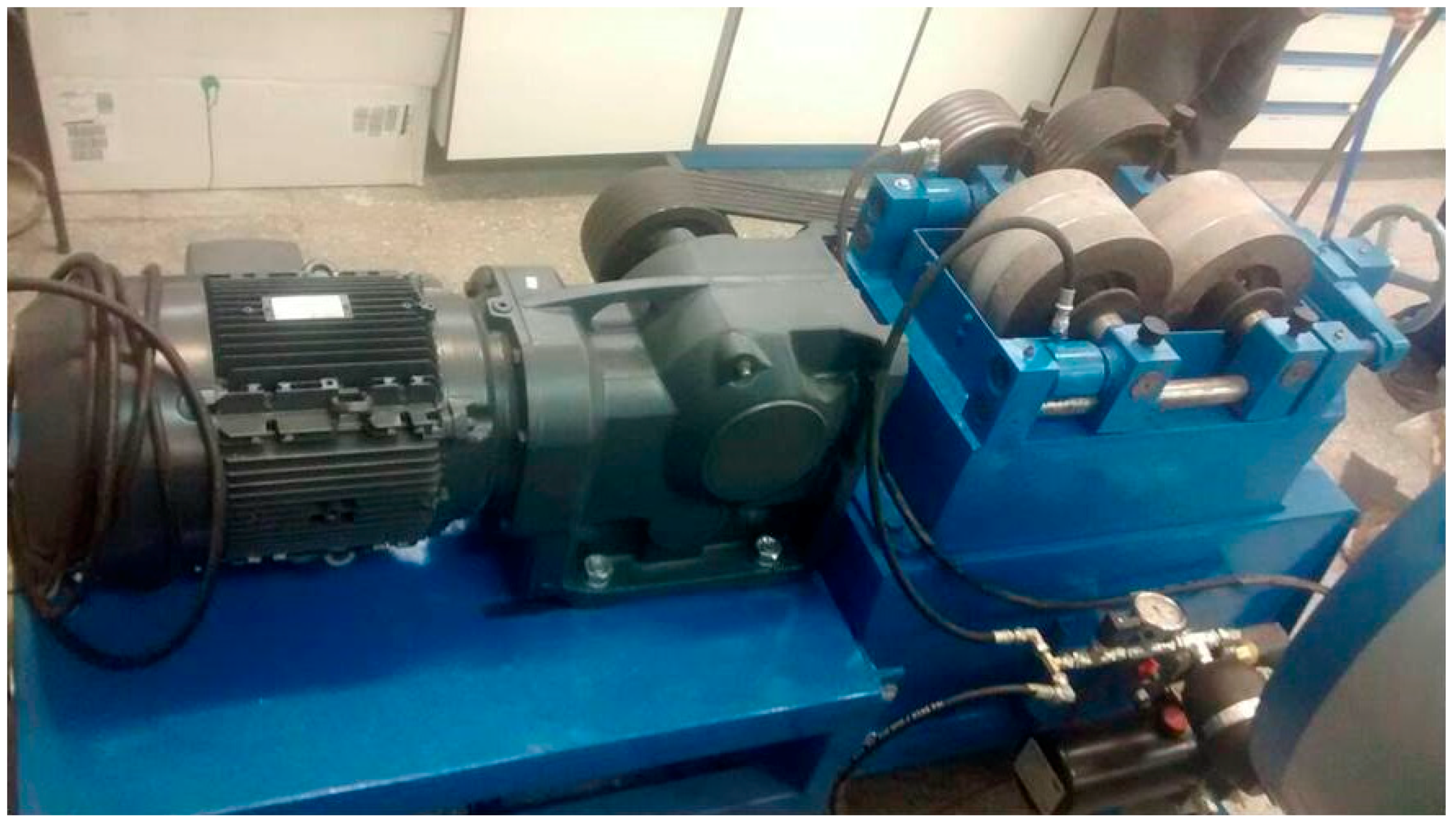
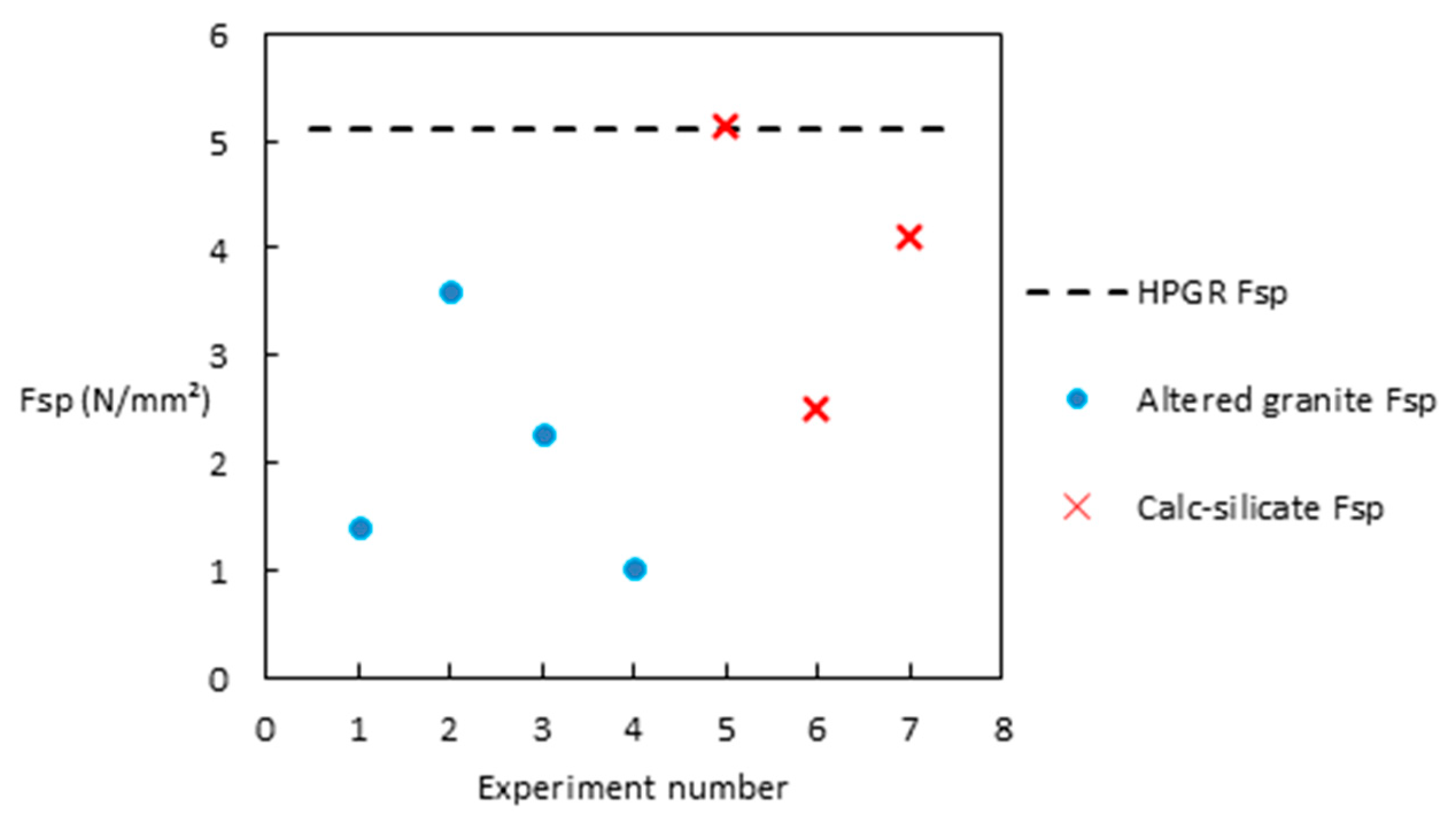
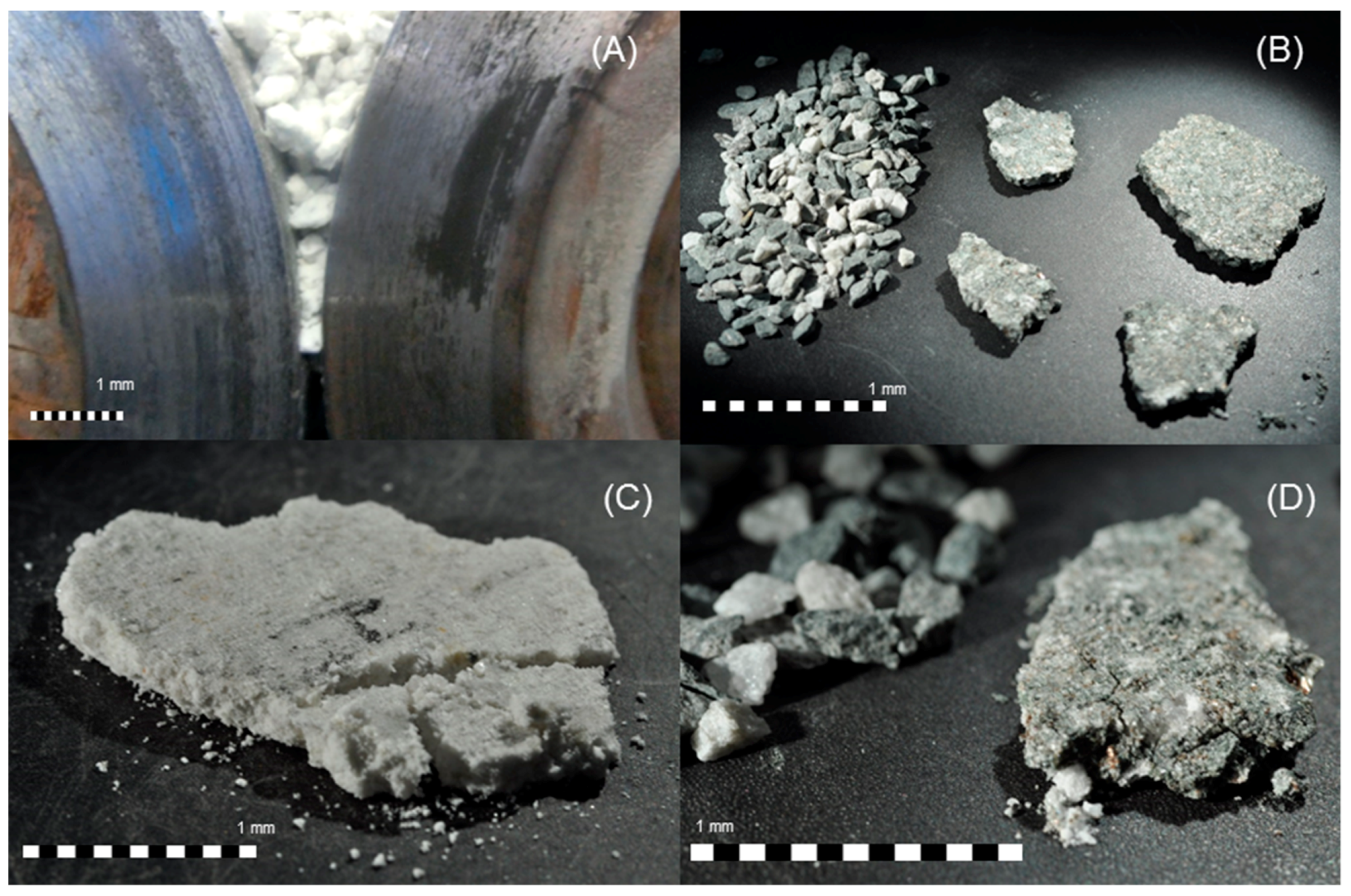

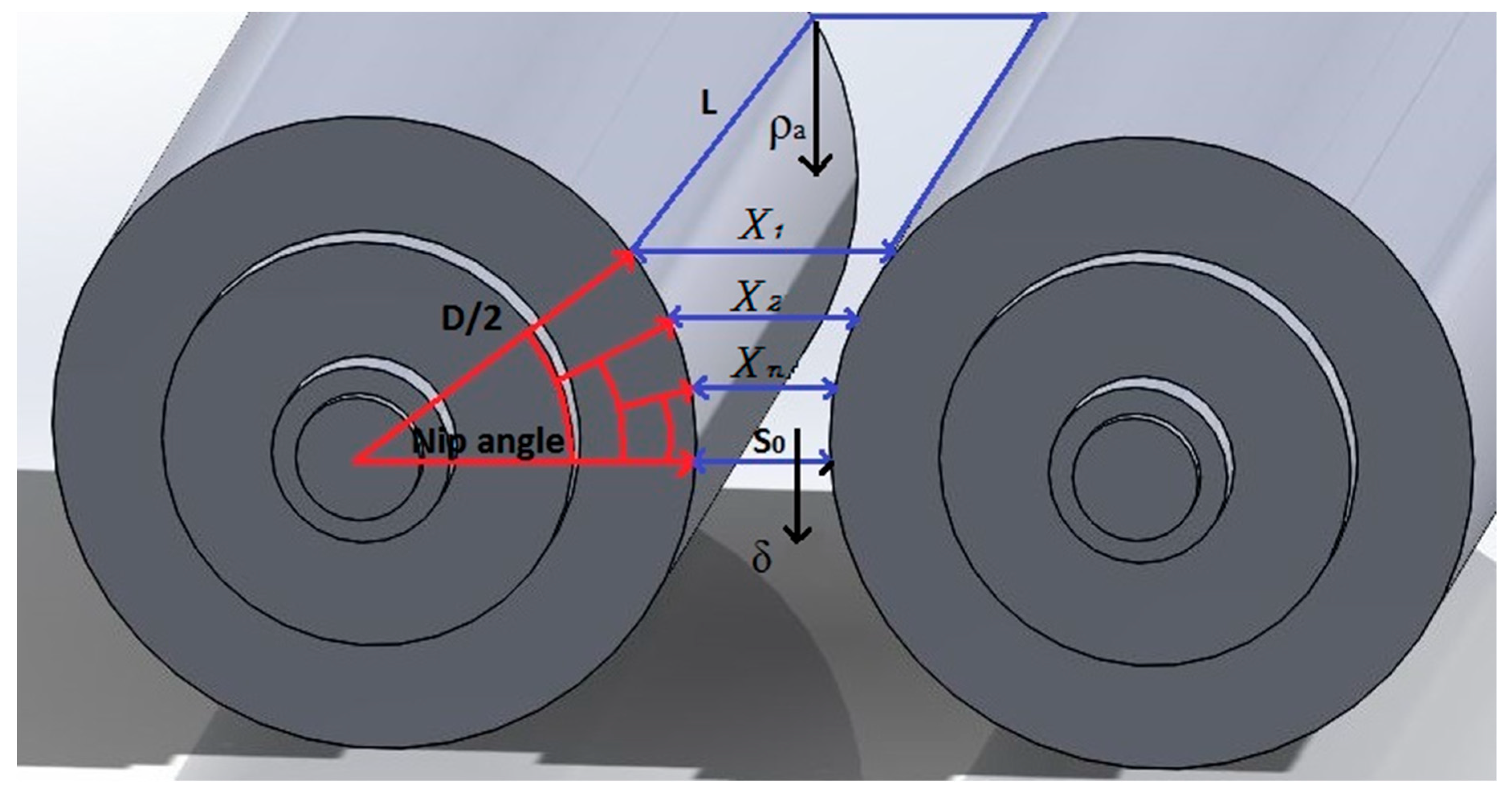

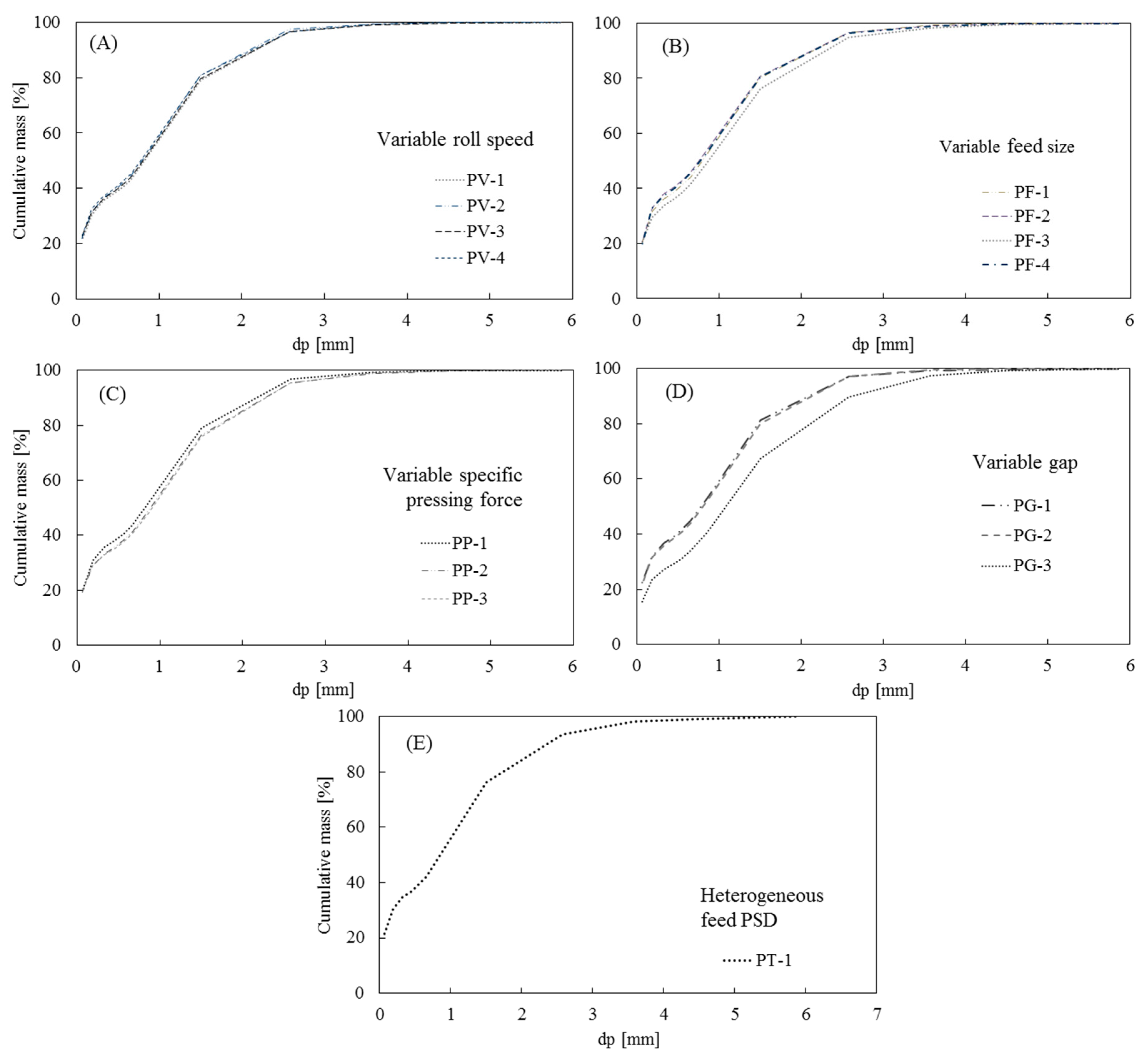
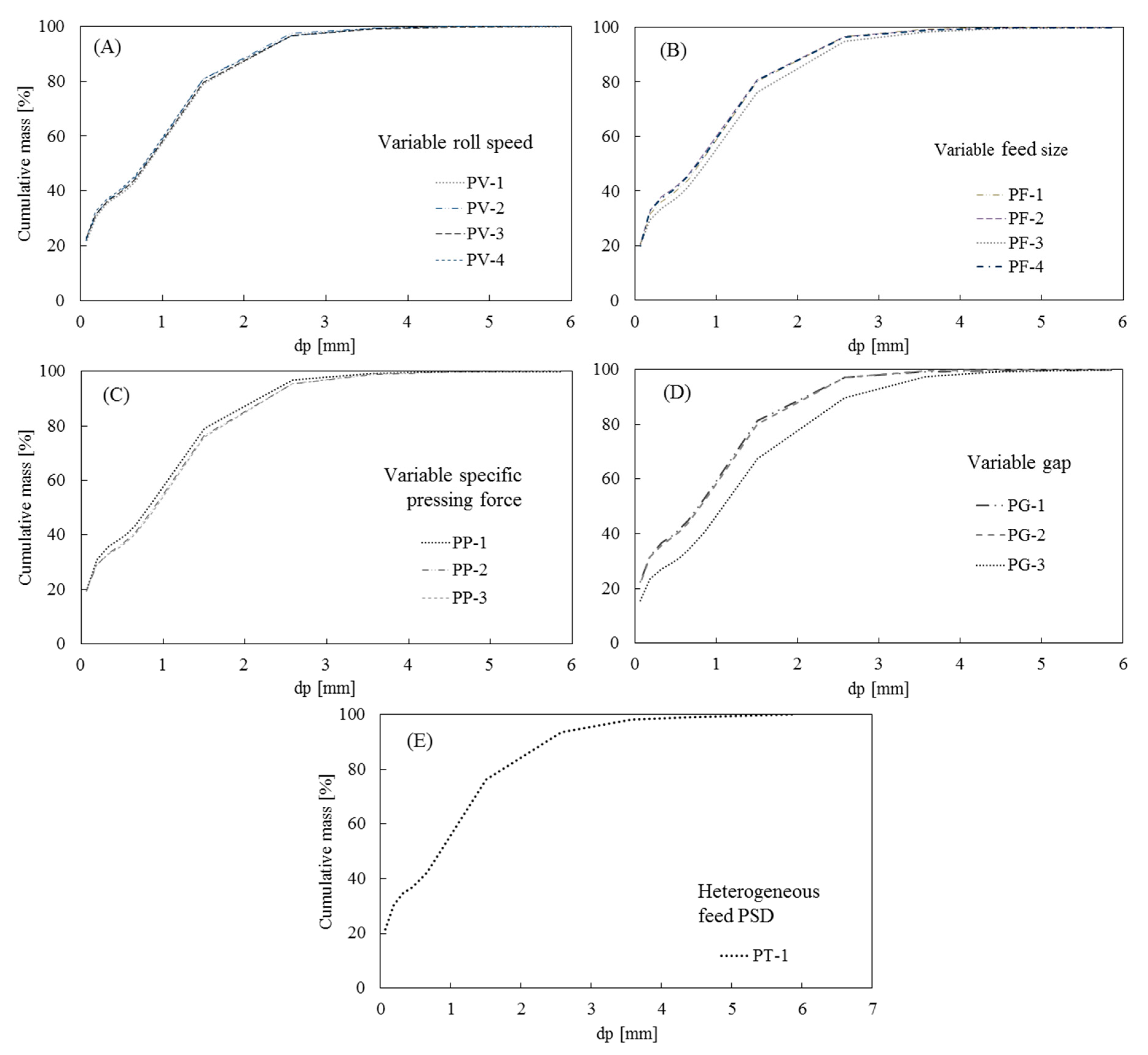
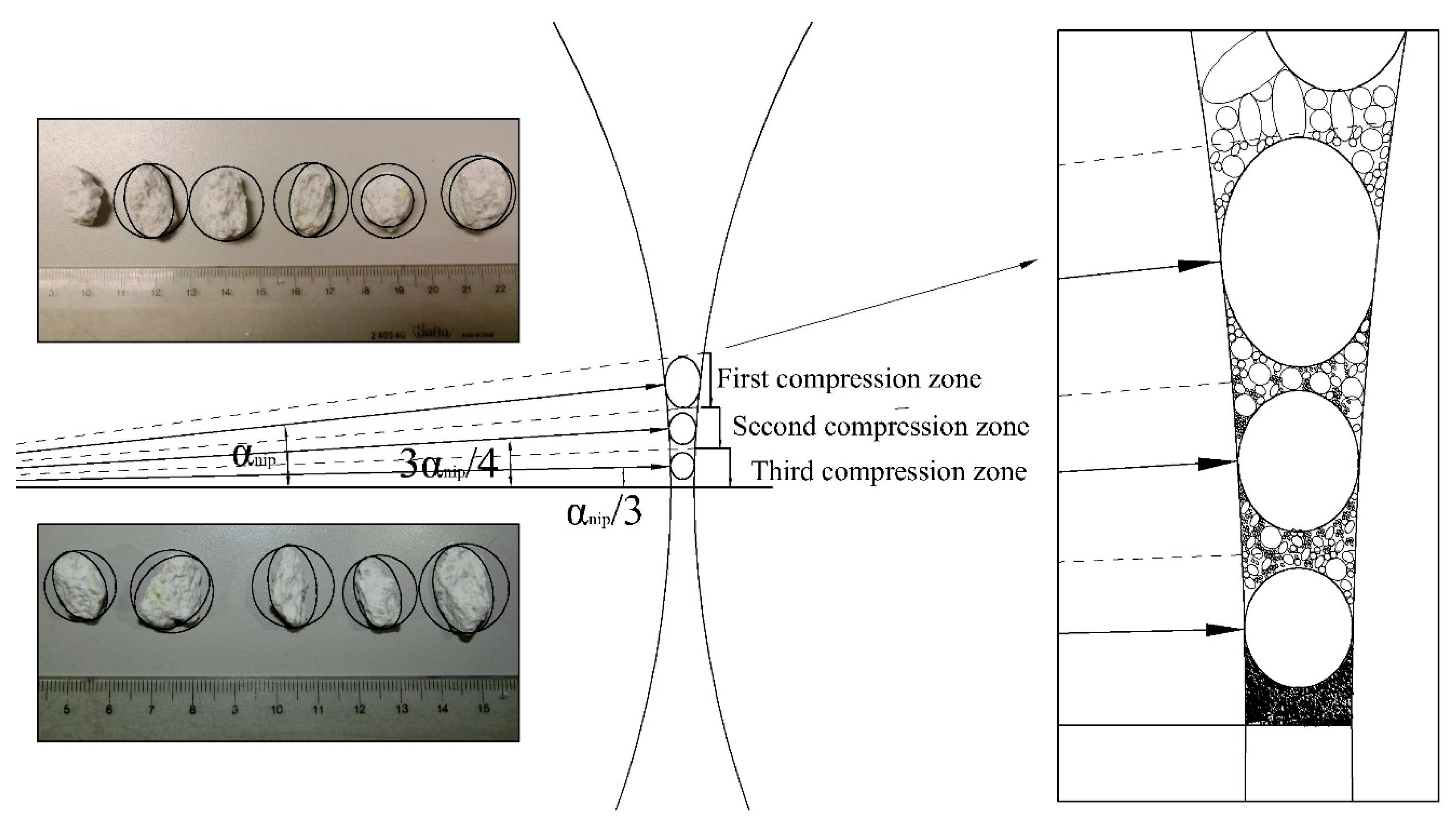
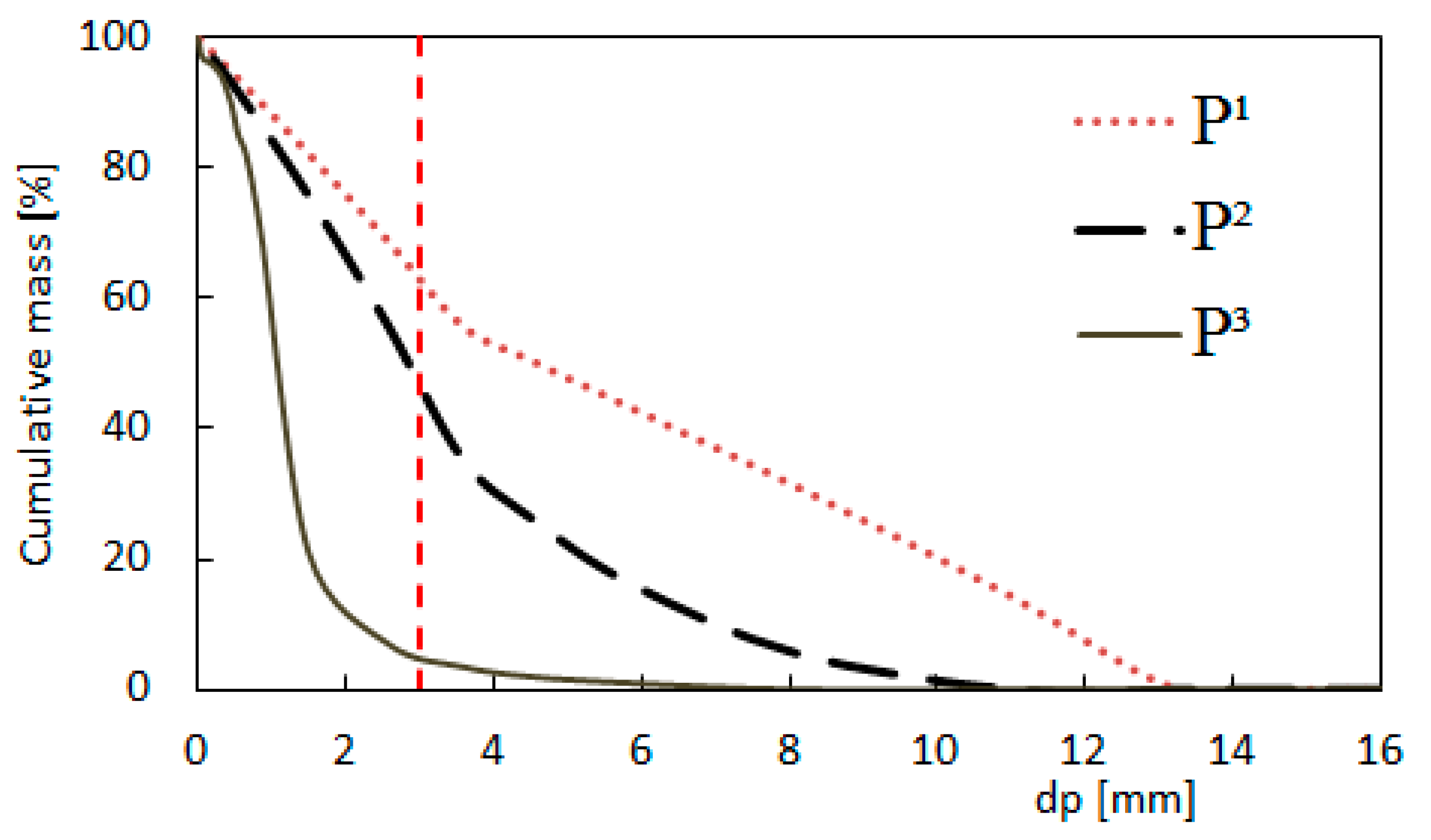
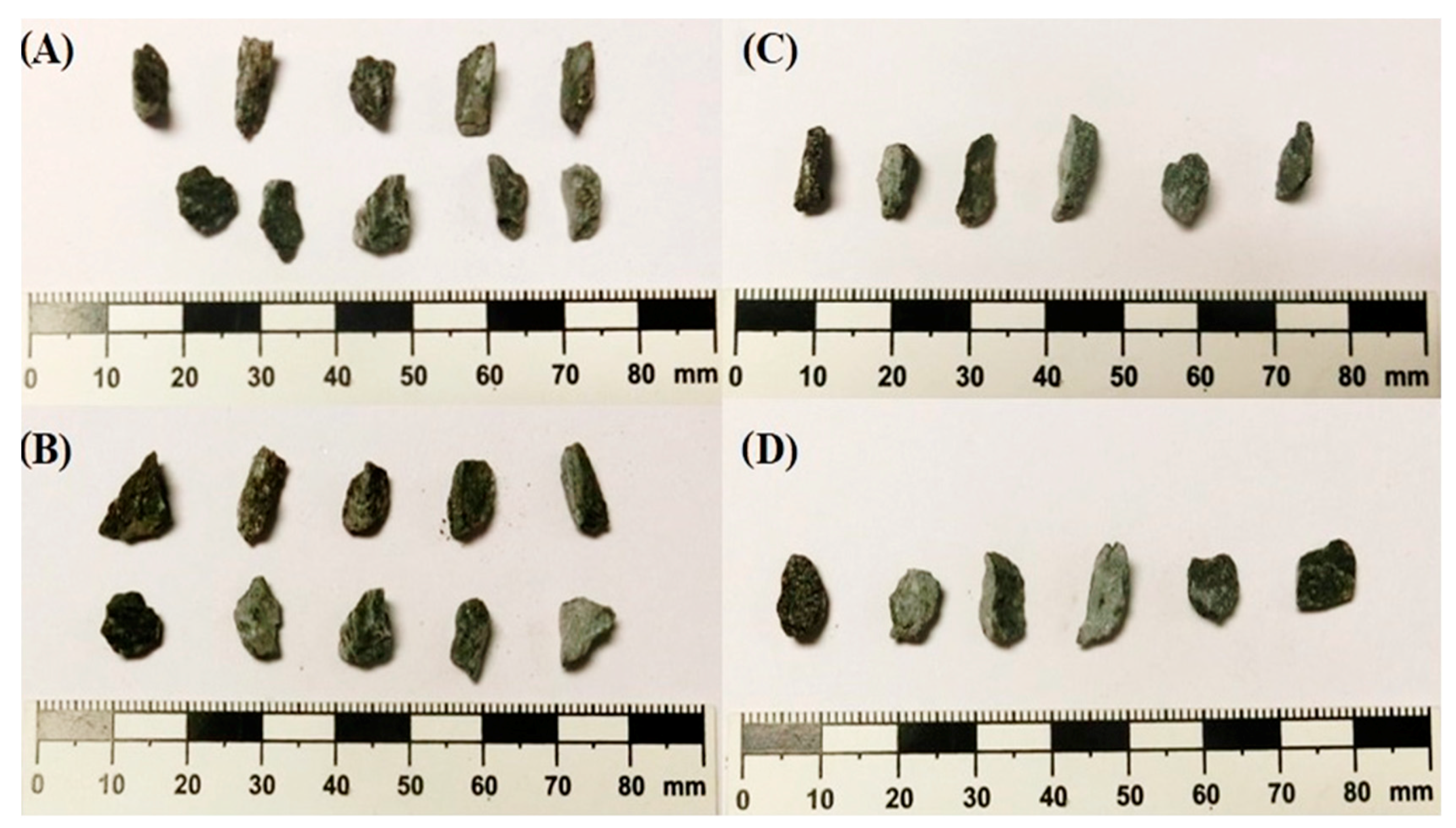
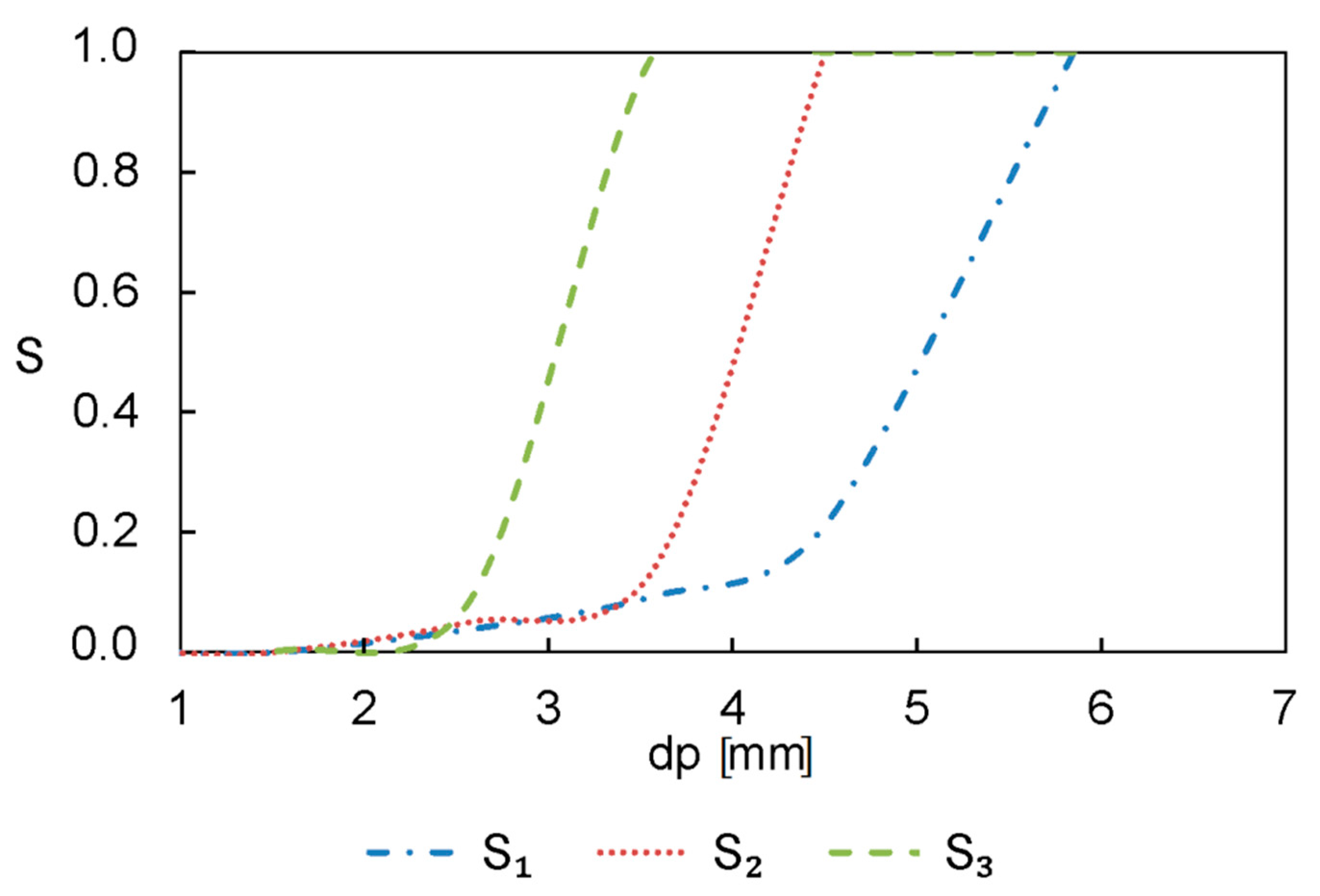
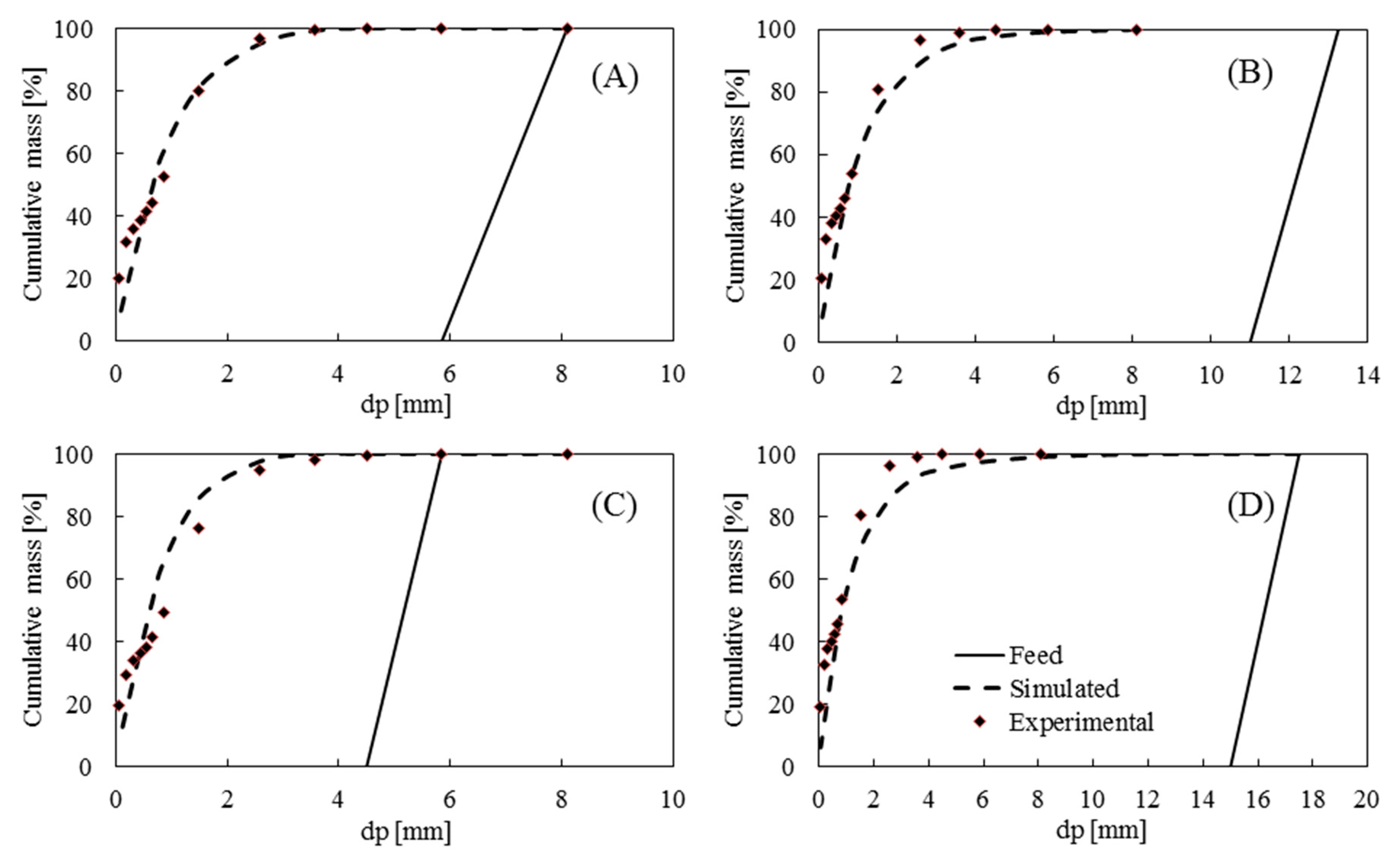
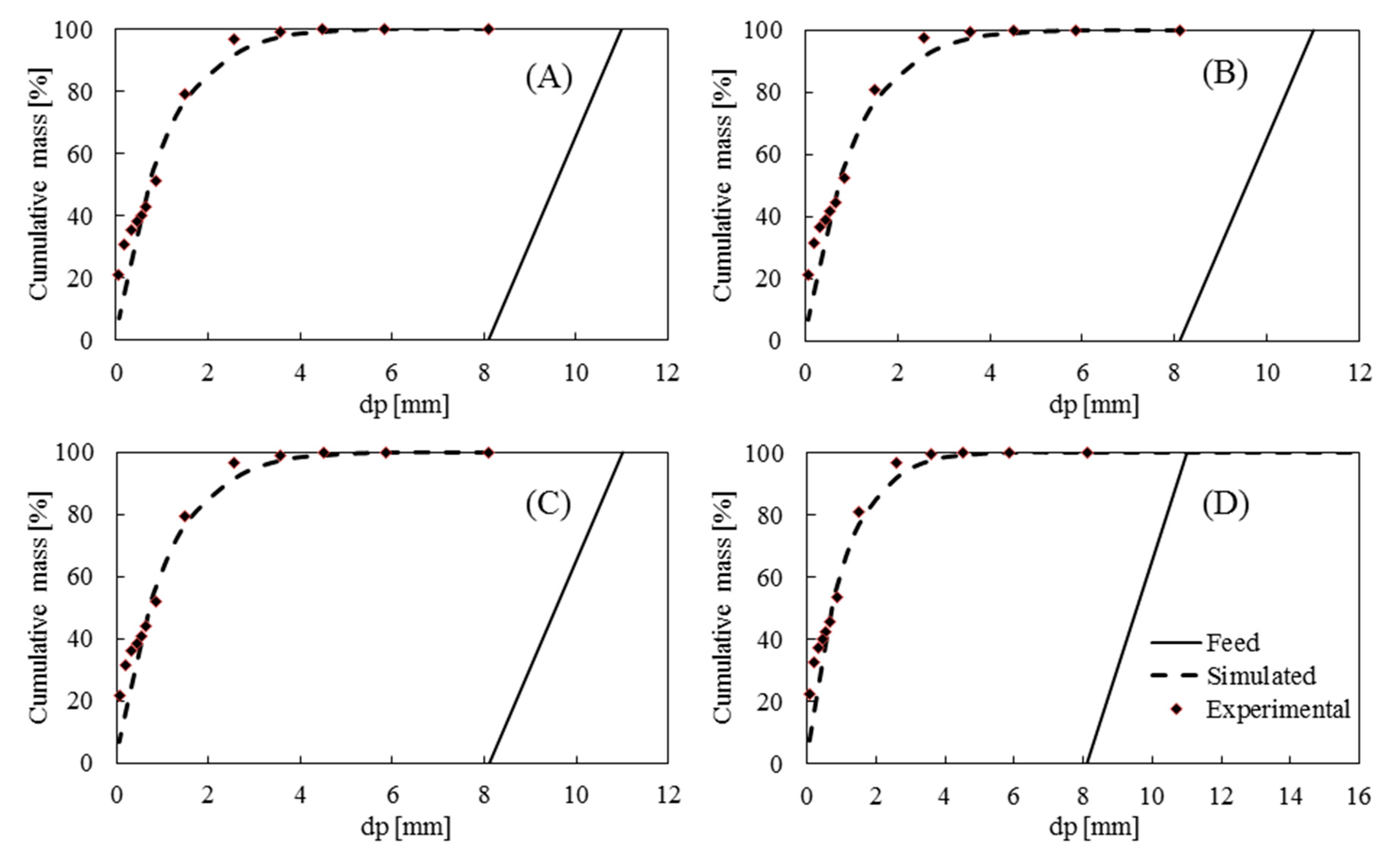
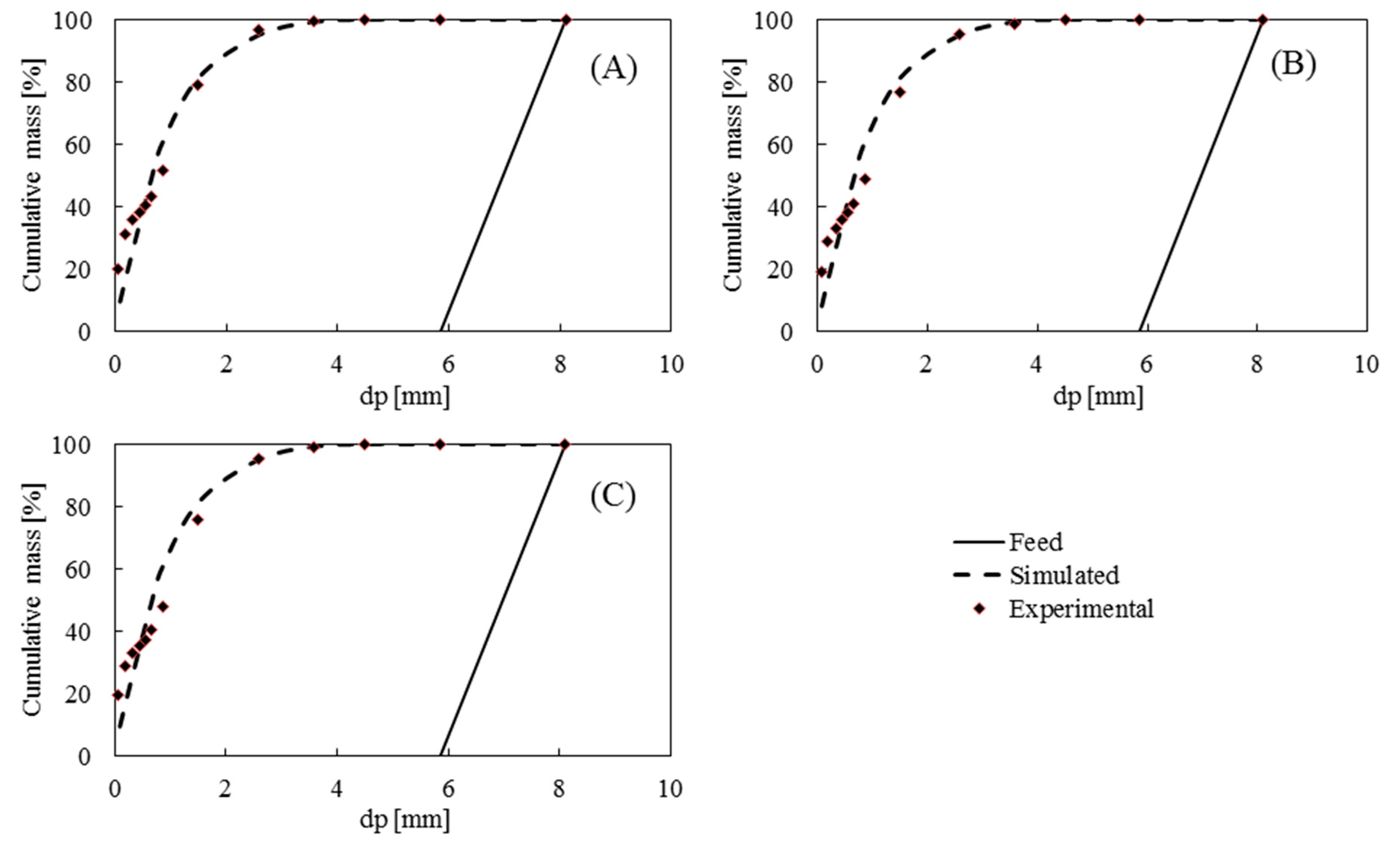
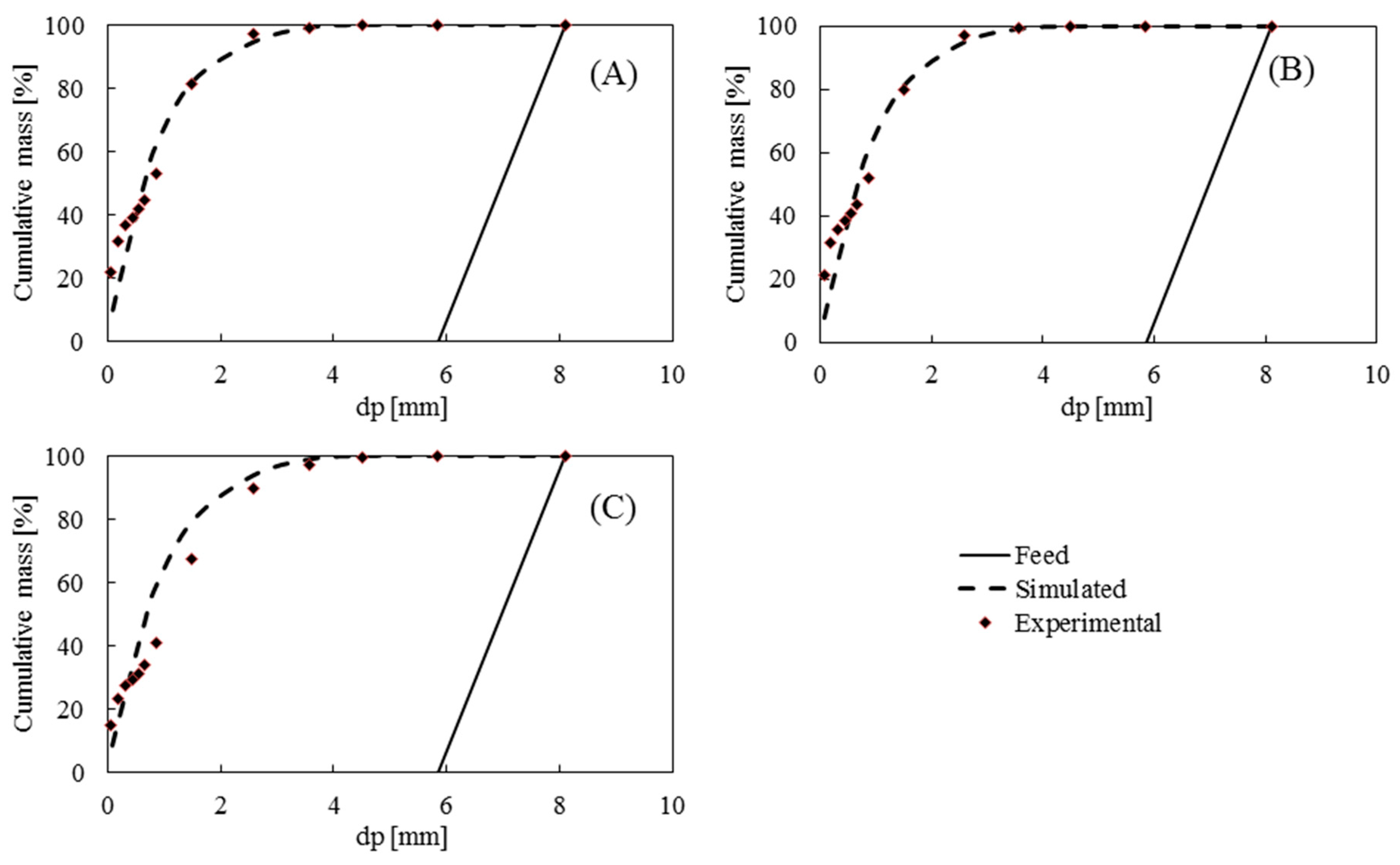
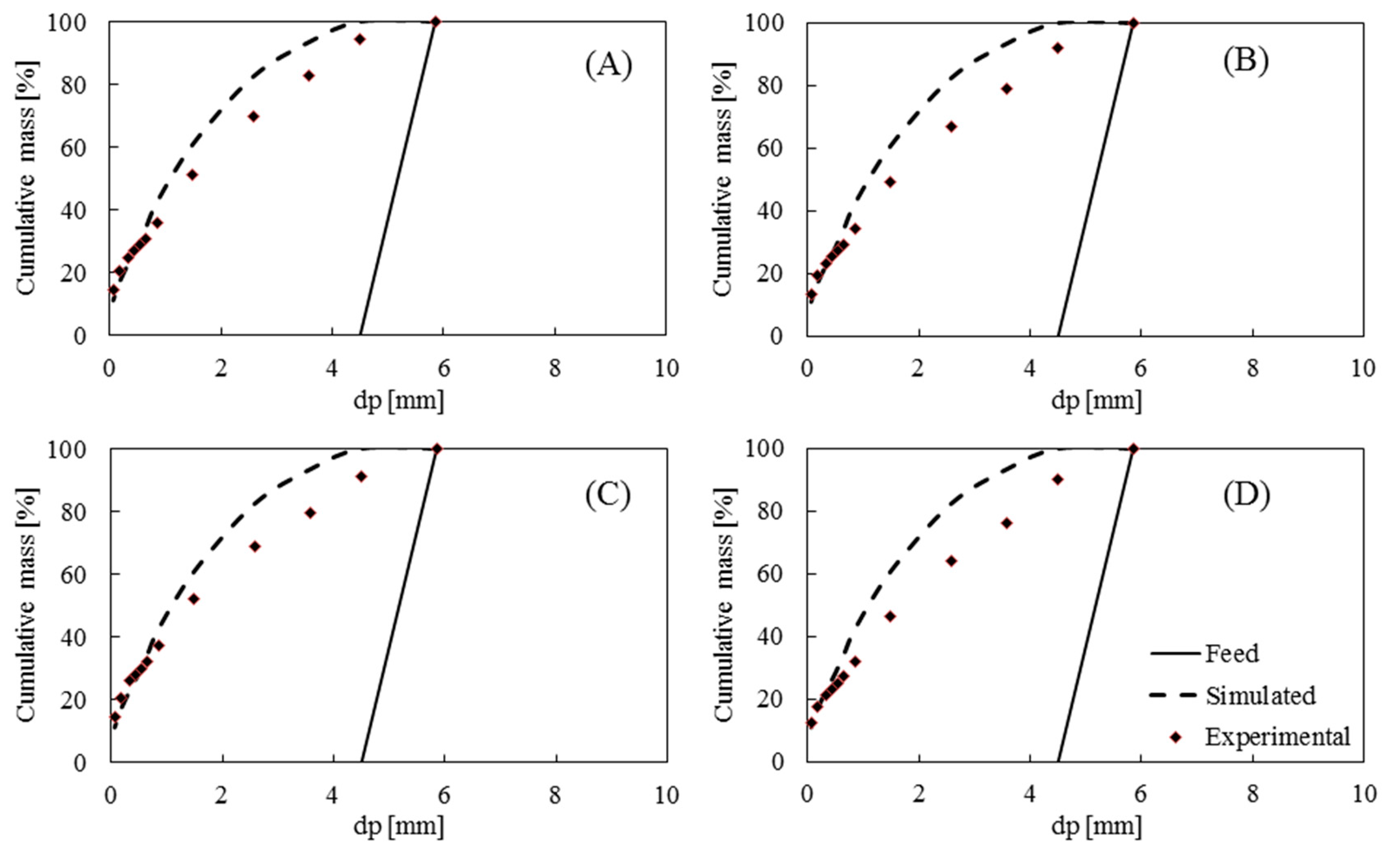
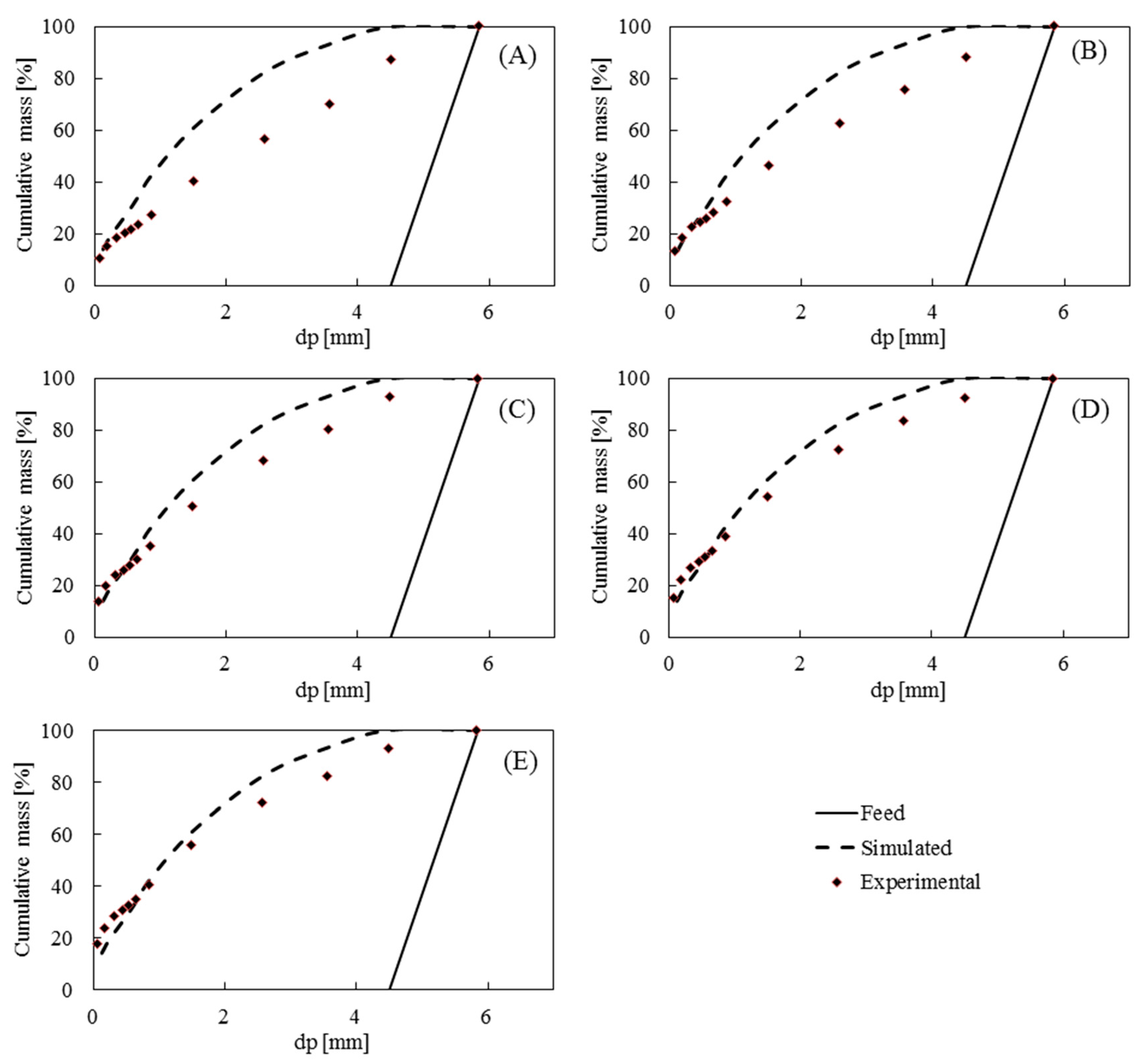

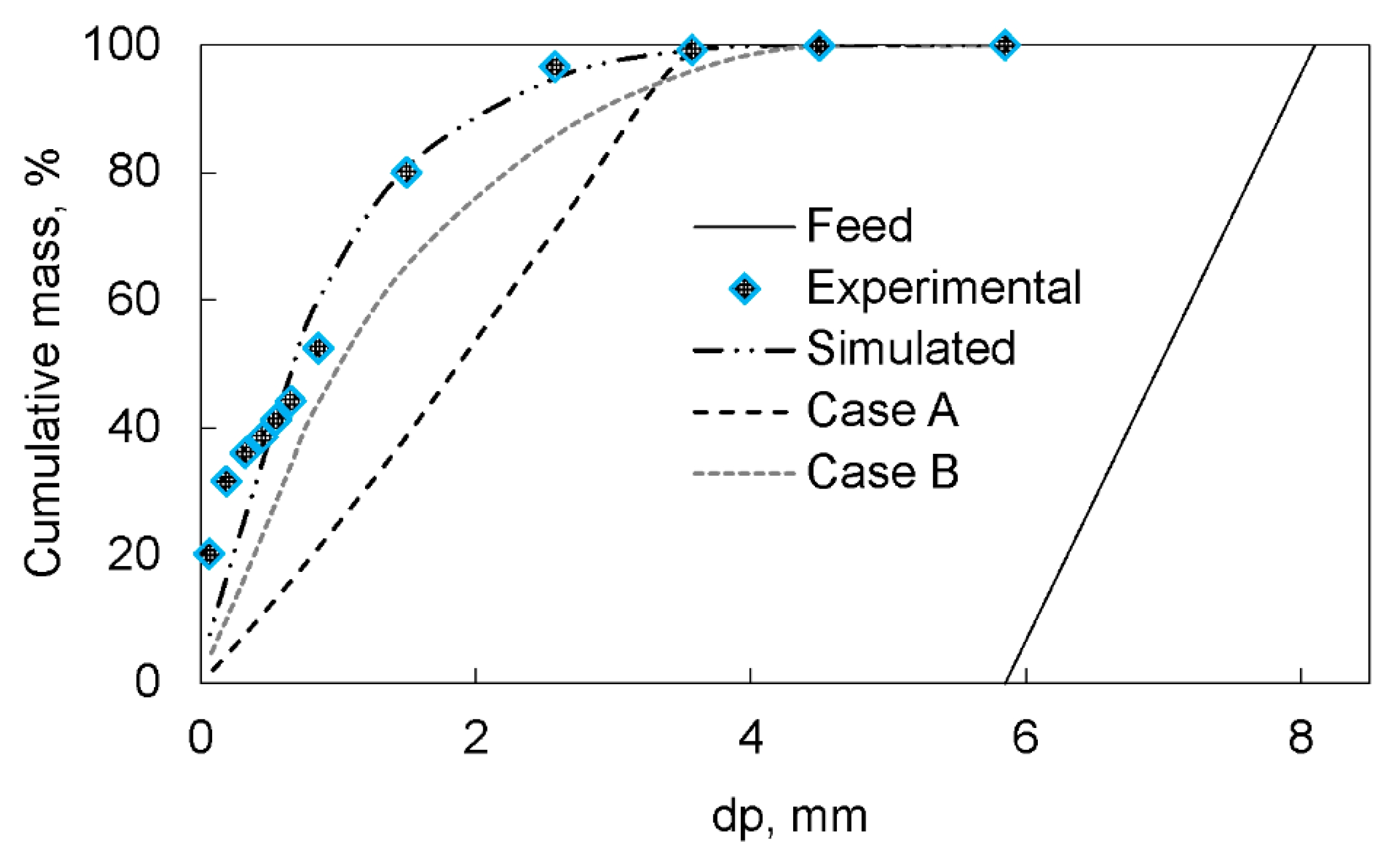
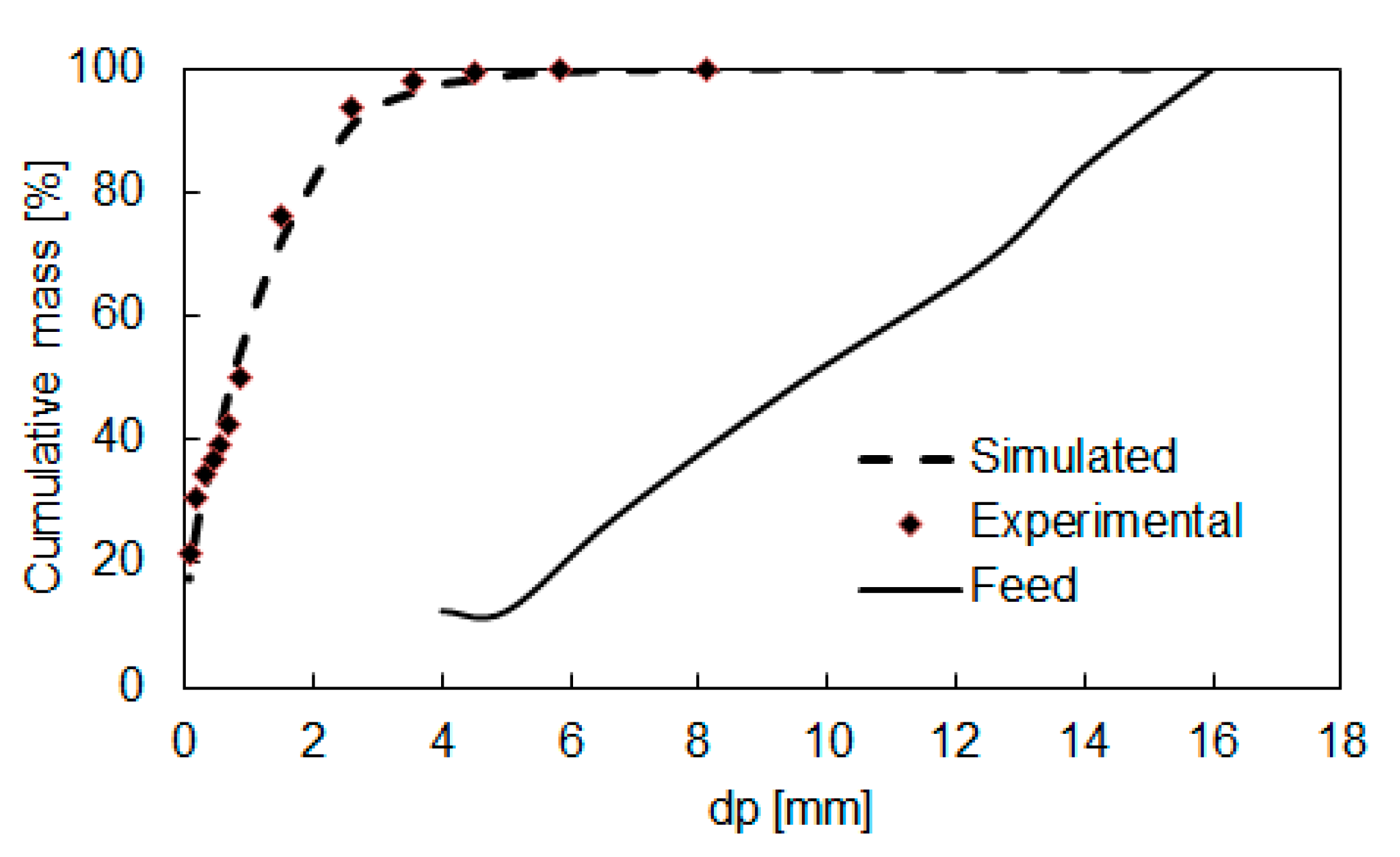
| Roll diameter (mm) | 250 |
| Roll length (mm) | 50 |
| Rolls surface type | Smooth |
| Quantity of piston | 2 |
| Piston diameter (mm) | 60 |
| Engine power (kW) | 15 |
| Parameter | Feed Size | Feed Density | Product Density | Frequency | Surface Speed | Specific Pressing Force | Throughput | Static Gap |
|---|---|---|---|---|---|---|---|---|
| Units | mm | t/m3 | t/m3 | Hz | m/s | MPa | t/h | mm |
| Symbol | Fe | ρ | δ | f | U | Fsp | Th | S0 |
| PV-1 | +9.5–12.0 | 1.22 | 1.65 | 50 | 0.73 | 2.50 | 0.52 | 3 |
| PV-2 | +9.5–12.0 | 1.21 | 1.62 | 40 | 0.58 | 2.50 | 0.49 | 3 |
| PV-3 | +9.5–12.0 | 1.19 | 1.65 | 30 | 0.44 | 2.50 | 0.52 | 3 |
| PV-4 | +9.5–12.0 | 1.18 | 1.59 | 20 | 0.29 | 2.50 | 0.49 | 3 |
| PF-1 | +6.7–9.5 | 1.20 | 1.58 | 40 | 0.58 | 2.50 | 0.52 | 3 |
| PF-2 | +12.5–14.0 | 1.12 | 1.51 | 40 | 0.58 | 2.50 | 0.49 | 3 |
| PF-3 | +4.5–6.7 | 1.21 | 1.60 | 40 | 0.58 | 2.50 | 0.52 | 3 |
| PF-4 | +16.0–19.0 | 1.15 | 1.52 | 40 | 0.58 | 2.50 | 0.49 | 3 |
| PP-1 | +6.7–9.5 | 1.18 | 1.59 | 40 | 0.58 | 2.50 | 0.59 | 3 |
| PP-2 | +6.7–9.5 | 1.21 | 1.54 | 40 | 0.58 | 1.50 | 0.52 | 3 |
| PP-3 | +12.5–14.0 | 1.19 | 1.56 | 40 | 0.58 | 1.30 | 0.49 | 3 |
| PG-1 | +6.7–9.5 | 1.12 | 1.60 | 40 | 0.58 | 1.30 | 0.52 | 2 |
| PG-2 | +6.7–9.5 | 1.12 | 1.50 | 40 | 0.58 | 2.50 | 0.49 | 3 |
| PG-3 | +6.7–9.5 | 1.22 | 1.50 | 39 | 0.58 | 2.50 | 0.47 | 4 |
| PT-1 | PSD | 1.24 | 1.54 | 40 | 0.58 | 2.50 | 0.45 | 5 |
| MV-1 | +4.5–6.7 | 1.46 | 1.94 | 50 | 0.73 | 2.50 | 0.46 | 3 |
| MV-2 | +4.5–6.7 | 1.46 | 1.85 | 40 | 0.58 | 2.50 | 0.48 | 3 |
| MV-3 | +4.5–6.7 | 1.46 | 1.67 | 45 | 0.65 | 2.50 | 0.48 | 3 |
| MV-4 | +4.5–6.7 | 1.46 | 1.79 | 35 | 0.51 | 2.50 | 0.51 | 3 |
| MP-1 | +4.5–6.7 | 1.46 | 1.81 | 50 | 0.73 | 1.25 | 0.46 | 3 |
| MP-2 | +4.5–6.7 | 1.46 | 1.72 | 50 | 0.73 | 1.75 | 0.48 | 3 |
| MP-3 | +4.5–6.7 | 1.46 | 1.77 | 50 | 0.73 | 2.50 | 0.51 | 3 |
| MP-4 | +4.5–6.7 | 1.46 | 1.75 | 50 | 0.73 | 3.25 | 0.52 | 3 |
| MP-5 | +4.5–6.7 | 1.46 | 1.79 | 50 | 0.73 | 4.50 | 0.49 | 3 |
| MT-1 | PSD | 1.46 | 1.81 | 50 | 0.73 | 2.50 | 0.52 | 5 |
| Material | Condition | k | n1 | n2 | n3 | Y0 |
|---|---|---|---|---|---|---|
| Altered granite | SC | 0.68 | 0.37 | 1.95 | 0.64 | 0.0036 |
| BC | 0.47 | 0.66 | 2.16 | 0.45 | 0.0045 | |
| Calc-silicate | SC | 0.60 | 0.61 | 2.32 | - | - |
| BC | 0.19 | 0.62 | 4.37 | - | - |
| α | xn (mm) | d1 (mm) | γ |
|---|---|---|---|
| 6.9 | 4.8 | 1.5 | 0.1 |
| 4.6 | 3.8 | 1.5 | 0.1 |
| 2.3 | 3.2 | 1.5 | 0.1 |
| Experiment | PV-1 | PV-2 | PV-3 | PV-4 | PF-1 | PF-2 | PF-3 | PF-4 | |
| Total | 6.8 | 7.2 | 7.1 | 7.5 | 6.4 | 7.8 | 7.9 | 8.6 | |
| Fine | 9.3 | 9.8 | 9.8 | 10.3 | 8.5 | 11.1 | 8.2 | 11.7 | |
| Coarse | 2.2 | 2.8 | 2.2 | 2.5 | 3.2 | 3.6 | 7.7 | 5.4 | |
| Experiment | PP-1 | PP-2 | PP-3 | PG-1 | PG-2 | PG-3 | PT-1 | MT-1 | |
| Total | 6.7 | 6.6 | 6.9 | 6.9 | 6.9 | 8.4 | 6.5 | 3.8 | |
| Fine | 9.0 | 8.8 | 9.2 | 9.3 | 9.3 | 10.3 | 9.4 | 1.9 | |
| Coarse | 1.1 | 2.0 | 2.2 | 1.0 | 1.1 | 5.3 | 1.6 | 5.1 | |
| Experiment | MV-1 | MV-2 | MV-3 | MV-4 | MP-1 | MP-2 | MP-3 | MP-4 | MP-5 |
| Total | 6.4 | 8.0 | 7.1 | 9.7 | 14.1 | 10.4 | 7.2 | 5.5 | 6.1 |
| Fine | 3.5 | 4.1 | 3.1 | 5.3 | 8.7 | 5.2 | 3.7 | 3.5 | 4.5 |
| Coarse | 8.9 | 11.5 | 10.3 | 13.6 | 19.3 | 15.0 | 10.2 | 7.5 | 7.8 |
| Material | Condition | k | n1 | n2 | n3 | Y0 |
|---|---|---|---|---|---|---|
| Altered granite | SC | 0.99 | 0.92 | 2.53 | 1.00 | 0.21 |
| BC | 0.89 | 0.00 | 2.28 | 0.43 | 0.50 |
© 2018 by the authors. Licensee MDPI, Basel, Switzerland. This article is an open access article distributed under the terms and conditions of the Creative Commons Attribution (CC BY) license (http://creativecommons.org/licenses/by/4.0/).
Share and Cite
Anticoi, H.; Guasch, E.; Ahmad Hamid, S.; Oliva, J.; Alfonso, P.; Bascompta, M.; Sanmiquel, L.; Escobet, T.; Escobet, A.; Parcerisa, D.; et al. An Improved High-Pressure Roll Crusher Model for Tungsten and Tantalum Ores. Minerals 2018, 8, 483. https://doi.org/10.3390/min8110483
Anticoi H, Guasch E, Ahmad Hamid S, Oliva J, Alfonso P, Bascompta M, Sanmiquel L, Escobet T, Escobet A, Parcerisa D, et al. An Improved High-Pressure Roll Crusher Model for Tungsten and Tantalum Ores. Minerals. 2018; 8(11):483. https://doi.org/10.3390/min8110483
Chicago/Turabian StyleAnticoi, Hernan, Eduard Guasch, Sarbast Ahmad Hamid, Josep Oliva, Pura Alfonso, Marc Bascompta, Lluis Sanmiquel, Teresa Escobet, Antoni Escobet, David Parcerisa, and et al. 2018. "An Improved High-Pressure Roll Crusher Model for Tungsten and Tantalum Ores" Minerals 8, no. 11: 483. https://doi.org/10.3390/min8110483
APA StyleAnticoi, H., Guasch, E., Ahmad Hamid, S., Oliva, J., Alfonso, P., Bascompta, M., Sanmiquel, L., Escobet, T., Escobet, A., Parcerisa, D., Peña-Pitarch, E., Argelaguet, R., & De Felipe, J. J. (2018). An Improved High-Pressure Roll Crusher Model for Tungsten and Tantalum Ores. Minerals, 8(11), 483. https://doi.org/10.3390/min8110483










